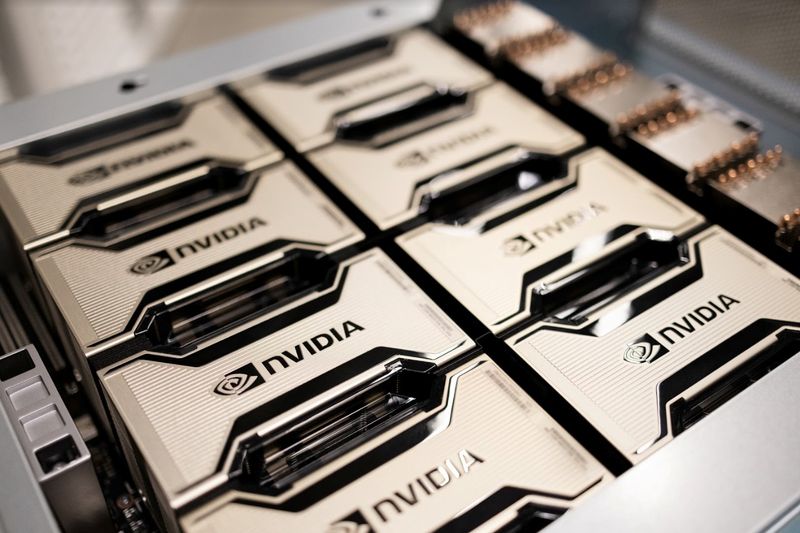Fubotv earnings beat by $0.10, revenue topped estimates
On Monday, Raymond (NSE:RYMD) James reaffirmed its Underperform rating on NVIDIA (NASDAQ:NVDA) stock, maintaining a price target of $150.00. The firm’s analyst, Srini Pajjuri, provided insights on the company’s performance and future expectations, highlighting several factors influencing the analysis. According to InvestingPro data, NVIDIA boasts a perfect Piotroski Score of 9, indicating exceptional financial strength, though current analysis suggests the stock is trading above its Fair Value. With a remarkable 114.2% revenue growth over the last twelve months, NVIDIA continues to demonstrate strong momentum in the semiconductor space.
Pajjuri noted that while there might be some upside to NVIDIA’s current quarter, the consensus estimates for the July 2025 quarter might not fully account for the impact of the recent H20 export restriction. NVIDIA has seen its revenue increase by $4-5 billion per quarter sequentially over the last six quarters, and this trend is expected to persist into the July 2025 quarter due to strong Blackwell product ramps. The company’s impressive 74.99% gross profit margin and robust return on assets of 82.2% underscore its operational efficiency. For deeper insights into NVIDIA’s financial health and growth prospects, InvestingPro offers comprehensive analysis through its Pro Research Report, one of 1,400+ detailed company analyses available to subscribers.
Despite this, the H20 restriction is anticipated to create a roughly $4 billion headwind, which could limit sequential growth in the second quarter compared to the consensus expectation of a $3 billion increase, totaling $46 billion. Nonetheless, the analyst expects NVIDIA’s management to convey optimism about the second half of the year, given robust hyperscale capital expenditure trends and the recent changes in AI diffusion rules.
Furthermore, Pajjuri mentioned that the Middle East is becoming a significant market, potentially driving the momentum of NVIDIA’s Blackwell products into calendar year 2026. This could mitigate concerns about a peak in AI spending. The potential imposition of Section 232 tariffs poses a near-term risk, but AI spending is seen as less sensitive to price or cost increases. InvestingPro analysis reveals that NVIDIA maintains a healthy financial position with a current ratio of 4.44 and operates with a moderate level of debt, positioning it well for continued market expansion. Investors should note that InvestingPro has identified over 20 additional key insights about NVIDIA’s financial health and market position.
Investor focus on gross margin is also a key point of interest, and NVIDIA’s management is expected to reiterate its previous projection of achieving mid-70% gross margins by the end of calendar year 2025. Raymond James emphasized its Strong Buy recommendation for NVIDIA, despite the near-term challenges and risks outlined.
In other recent news, NVIDIA has unveiled its NVLink Fusion technology, which aims to enhance AI infrastructure by integrating CPUs from companies like Fujitsu and Qualcomm (NASDAQ:QCOM) Technologies with NVIDIA GPUs. This development is part of a broader effort to scale up AI capabilities and meet the demands of data-intensive applications. Meanwhile, Mizuho (NYSE:MFG) Securities has raised NVIDIA’s stock price target to $168, maintaining an Outperform rating ahead of the company’s earnings report. The firm anticipates a mixed near-term performance but expects a strong second half of the year.
HSBC has maintained a Hold rating on NVIDIA with a price target of $120, projecting first-quarter sales to align with management’s and consensus estimates. The analyst anticipates challenges due to a $5.5 billion write-off from licensing restrictions in China, which may impact gross margins. Additionally, NVIDIA’s sales for the second quarter of fiscal year 2026 are expected to meet market predictions, despite the loss of H20 AI GPU revenues.
The company is also experiencing fluctuations in the broader market context, as shares of NVIDIA and other tech giants, collectively known as the "Magnificent Seven," have seen varied movements. While NVIDIA’s shares recently fell by 2.3% in premarket trading, there is optimism about its product pipeline and market strategy. Investors are closely watching NVIDIA’s upcoming earnings report to gauge its financial health and ability to meet expectations.
This article was generated with the support of AI and reviewed by an editor. For more information see our T&C.
